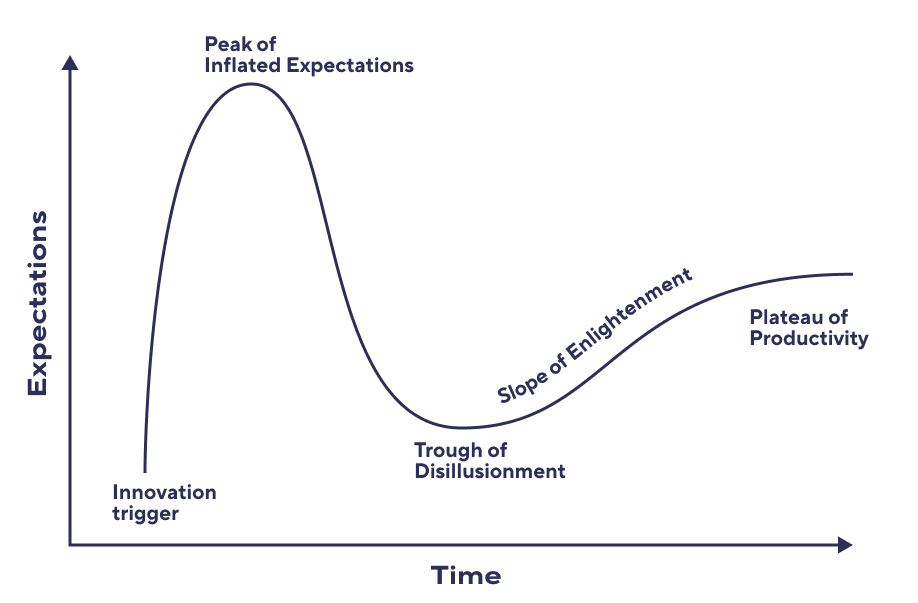Riding the hype is one of the marketing tactics any business could use. With the technological advances we witness on a regular basis, the latest hype wave involves artificial intelligence. Its promise is to automate mundane tasks saving time, effort and money while keeping the quality of the outcome at least on par with the humans they are supposed to replace.

Remember chatbots? Or Google Glasses?
Shift scheduling – or workforce scheduling if you prefer a standardized language – didn’t escape the hype wave either. It is actually one of those ideas which lies on the surface: why would anyone need a dedicated employee to schedule staff if AI could surely do it better? The expectations are high, too. Surely, AI-based scheduling could match scheduling requirements with the skills of individual employees while keeping the schedule highly efficient, taking into consideration all different aspects of what a perfect schedule should reflect.
Unfortunately – yes, bad news first – this is not as trivial as the idea could suggest. Since the 1950s (!) the Nurse Scheduling Problem has remained unresolved. In a nutshell, this problem deals with hard (shift coverage, rest hours, qualifications match) and soft (Paul prefers to work with Paulina, the shifts difficulties should be equally balanced between the whole team, etc) constraints, and while pure mathematical equations are somewhat resolvable, the soft constraints add quite a challenge to the whole idea.

But ChatGPT!
If you ever worked with any AI agent you should know by now that wording your question should be considered carefully. As soon as AI detects bias in your question, it will try to cater to it - and here you go, you are a genius! It works fine if you want to win an argument with an unsuspecting partner of yours, but try to explain to Karen why she is always scheduled on Friday and Saturday nights with her only day-off on Wednesday. “Oh, Kevin from the HR department now uses this brand new AI scheduler - so this is what AI has scheduled”. Good luck, Kevin, making friends with anyone on that team. 1
But custom AI!
Who are we kidding here? No SaaS company in the workforce scheduling business would take on the trouble of setting up, training, maintaining and constantly developing a custom AI (worth millions) to make a Kevin happy. At that point, it’s not a hype train, but a costly investment in hardware and AI experts who, let’s be honest, have much more interesting problems to solve. And frankly, if any SaaS app claims to use AI for automatic scheduling, it either uses ChatGPT (please don’t) or just wraps its algorithms in the latest hype terms.
Another thing to remember: AI in its today’s form is notoriously bad at keeping track of what it said just two paragraphs before. Yes, it keeps the context, but the details are superfluous. Yes, those shift scheduling details you’ve hoped to solve in the first place.
With all of this sounding like we had a bad day, it is worth mentioning that AI does help a lot and it shines with languages2, translations, late night talks about your ex and some filtering functions. Unfortunately, shift scheduling is not its trump card, yet.
So…
what options do HR managers who oversee scheduling in a mid-size business have? Let’s see.
Excel or Google Sheets are no longer an option.
Pen and paper work fine for taking notes only.
WhatsApp et al are reserved for family chats and sharing memes.
Which leaves us with two options: word of mouth or specialized apps.
The good news is – there are plenty of apps to choose from. While this is not a catalogue to list such apps, we can confidently state what exactly a manager should be looking for in a rota scheduling app to be able to efficiently schedule the team.
For one, the app should be easy to handle. Sounds trivial at first, but it is not. As any specialized B2B software, scheduling apps inevitably present a learning curve for the first-time users, so being able to navigate the app and use its core functions without friction is a key factor. Bad design has no excuses these days. TeamUltim, for example, is praised by its long-time customers for the ease of use and straightforward user interface.
Secondly, the app should allow for flexibility of business requirements. Early shifts, late shifts, night shifts, two shifts in a row, open shifts, priority shifts - you name it. Kevin doesn’t need AI per se, but he absolutely has to be able to design the schedule around hard and soft constraints we’ve discussed earlier. At the end of the day, the app should adapt to a business, not the other way around. Also, if the app provides shift templates to reuse when the scheduling periods follow a pattern (TeamUltim does) - this is a plus.
Next up is compliance, a foreign word that basically means “we do our best to follow the law and stay likable”. Almost all of the big apps promote their compliance capabilities as though this is the pinnacle of workforce management. Unless we are talking about thousands of people working across multiple factories in different time zones, realistic requirements for a small- to medium-sized business trickle down to warnings about shift overlaps, rest times between shifts and shift durations. Maybe shift break times, too. Being able to set up those constraints to match your local labor laws is what counts. Again, being a European company, TeamUltim knows the importance of these regulations for its customers.
Last and not in any way the least is the ability of a shift scheduling app to handle humans. With the entirety of semi controlled chaos happening in the lives of every human being (including Kevins and Karens3), the app should at the very least provide for shift swapping and absence management - and preferably all available on a mobile device. Statistics for TeamUltim shows that this is 90% true.
The list could be much longer of course, but these are the core features needed for a fluid and robust shift management. If the app can track attendance (check-in and check-outs) and generate reports which you can feed to your beloved Excel, then it is definitely worth trying out. As you can guess, TeamUltim does both – and has an extended 30 days free trial with no strings attached.
So back to the original question: can AI substitute shift scheduling apps?
Our take – no, not today. While on the surface it looks like the task should be trivial, it turns out it is not. And while we can’t completely rule out the possibility that some company has actually developed a very complicated AI model to robustly automate scheduling, we very much doubt that such a product would be within a budget for a business where everybody knows who Kevin is and why Karen would be unhappy (we are talking about 50-200 people).
But TeamUltim is!
-
On the other hand you’ve saved Kevin an extra hour for his scheduling routine, so he might as well go and find new friends elsewhere. ↩︎
-
This article was written by a human and proof-read and illustrated by an AI. ↩︎
-
We have nothing against Kevins or Karens really - we know some, as those are lovely people. Blame the internet! ↩︎
Discuss @ Medium
